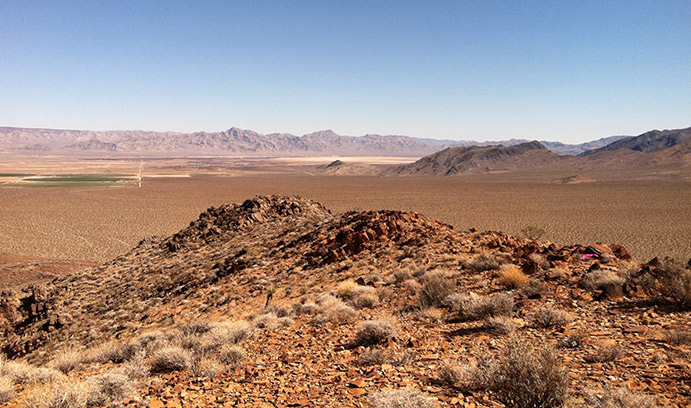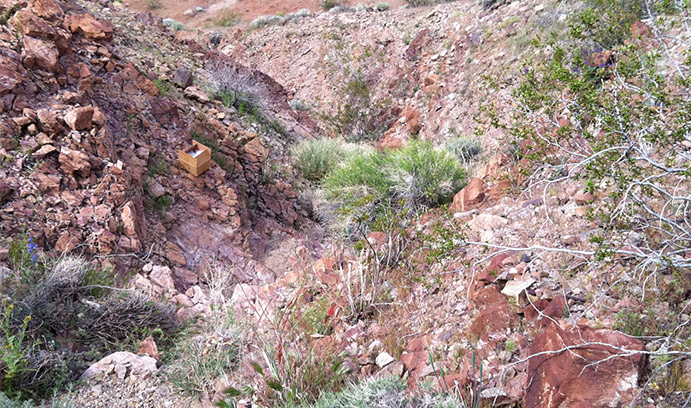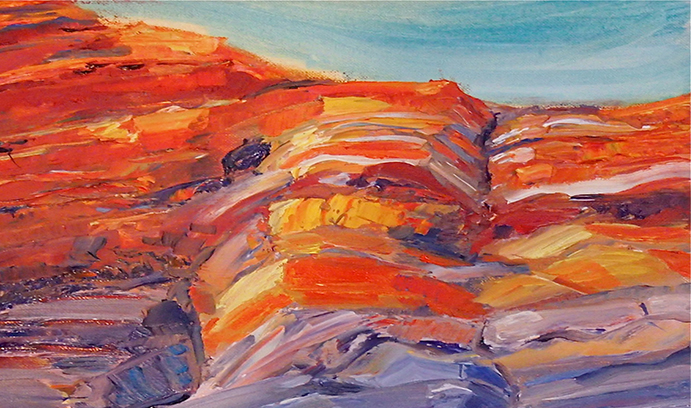Ken Kodama Delivers Bullard Lecture at AGU Conference

The Nopah Range in California’s Inyo County, near Death Valley National Monument, contains limestone deposits more than 550 million years old. Paleomagnetic measurements taken from these deposits, says Ken Kodama, offer clues to the Earth’s ancient natural climate cycles. (Photo courtesy of Ken Kodama)
Ken Kodama’s reputation as a preeminent geophysicist and expert in paleomagnetism was affirmed earlier this month when he delivered the Edward Bullard Lecture at the annual meeting of the American Geophysical Union.
Kodama, a professor of Earth and Environmental Sciences, joined the Lehigh faculty in 1978. In his research, he studies the magnetism of thick sequences of sedimentary rock and the paleomagnetic measurements that determine the latitudes at which rocks were formed.
Paleomagnetism, says Kodama, enables scientists to reconstruct the ancient positions of the continents and provides the best primary evidence for the theory of plate tectonics. Paleomagnetism also sheds light on the genesis and history of the magnetic field that protects the Earth from solar radiation and solar wind.
The American Geophysical Union (AGU) has more than 62,000 members from 144 nations. The Bullard Lecture is a major, hour-long address given to AGU’s Geomagnetism, Paleomagnetism and Electromagnetism Section.
The lecture is named for Edward Bullard, a 20th-century British geophysicist who made significant contributions to the fields of plate tectonics and magnetism. Bullard also advanced the theory of continental drift with his discovery that the edges of the world’s continents, when measured not at the shoreline but at a depth of about 3,000 feet, join together to form a near-perfect fit.
Kodama’s lecture was titled “Determining the Accuracy of Paleomagnetic Remanence and High-Resolution Chronostratigraphy for Sedimentary Rocks Using Rock Magnetics.”
By measuring the magnetism of the sedimentary deposits, Kodama said, it is possible to identify ancient natural climate cycles, which typically last 400,000, 100,000, 40,000 or 20,000 years.
“These cycles are caused by small perturbations in the Earth’s orbit that change the amount of sunlight coming into the top of the Earth’s atmosphere,” Kodama said. “The cycles can affect the timing and duration of an ice age, the strength of monsoons, and the amount of global precipitation.”
Kodama and his students have studied sedimentary deposits in regions of the Earth that contain limestone deposited 550 to 560 millions of years ago. Their goal is to learn more about the shift in the ratio between two isotopes of carbon—13C and 12C—that occurred in the Earth’s oceans during this time.
The shift coincided with the oxidation of the world’s oceans and a growth in the amount of oxygen in the Earth’s atmosphere. The two phenomena helped triggered the Cambrian Explosion, when life on Earth became multicellular, Kodama said.
“Our job as geophysicists is to try to determine the duration of the shift in this ratio,” he said. “In the last few years, we have measured the thickness of sedimentary deposits in Death Valley, Southern Australia and South China, and we estimate that the shift lasted 8-9 million years.”
Earlier in his career, Kodama studied the accuracy of sedimentary rocks’ paleomagnetism and concluded that geologists seeking to determine the ancient latitude at which rocks were formed should take into account the effect of burial compaction on the direction of the rocks’ magnetism.
“After rocks form,” he said, “they get buried and compacted. In the process, their magnetism gets flattened, which gives an inaccurate reading of ancient latitude. You have to take into account the inclination, or the angle of compaction.”
Kodama has published numerous articles in scholarly journals and is the author of two books: Paleomagnetism of Sedimentary Rocks: Process and Interpretation (2012) and, with Linda A. Hinnov, Rock Magnetic Cyclostratigraphy: Analytical Methods in Earth and Environmental Science (2014).
Story by Kurt Pfitzer
Posted on:






